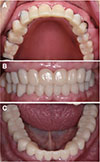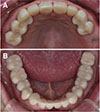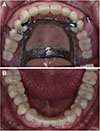Abstract
Excessive tooth wear results in unacceptable damage to the occlusal surface and can cause pulpitis, occlusal disharmony, dysfunction, and unesthetic result. Patients with severe attrition have to be classified as several types relative to the vertical dimension of occlusion (VDO) and the interocclusal distance for the prosthetic space. The patient in this case was a 80 - year - old woman who lost support of posterior occlusion and collapsed of the occlusal plane due to confrontation of the opposing teeth, accompanied by an increase in the number of remaining bristles, resulting in a loss of intermaxillary space for prosthesis. In this case, treatment with increased vertical dimension may have stability if the increase in vertical occlusal height is minimized within the required range, and a stable occlusal contact is provided after an increased vertical occlusal height stabilization period. After the new VDO had been confirmed under interim fixed restorations, definitive fixed restorations were produced. Through these treatment processes, we obtain satisfactory results that are functional and aesthetically pleasing.
Figures and Tables
Fig. 2
Preoperative intraoral view showing uneven occlusal plane. (A) Occlusal view of maxilla, (B) Lateral view (right side), (C) Frontal view, (D) Lateral view (left side), (E) Occlusal view of mandible.

Fig. 3
Interim prostheses. (A) Occlusal view of maxilla. (B) Frontal view, (C) Occlusal view of mandible.

Fig. 5
Computer Assisted Design (3shape, Copenhagen, Denmark). (A) Tooth arrangement, (B) Proximal plate, (C) Buccal contour.

Fig. 6
Computer-aided design (Rhinoceros, LA, USA). (A) Tool for rest seat, (B) Making rest seat on maxillary left side, (C) Section of surveyed fixed partial denture (FPD), (D) Making rest seat on maxillary right side.

References
1. Lambrecht JR. The influence of occlusal contact area on chewing performance. J Prosthet Dent. 1965; 15:444–450.

2. Rivera-Morales WC, Mohl ND. Restoration of the vertical dimension of occlusion in the severely worn dentition. Dent Clin North Am. 1992; 36:651–664.
3. Choi HS, Moon JE, Kim SH. The application of CAD/CAM in dentistry. J Korean Dent Assoc. 2012; 50:110–117.
4. Han J, Wang Y, Lü P. A preliminary report of designing removable partial denture frameworks using a specifically developed software package. Int J Prosthodont. 2010; 23:370–375.
5. Kern M, Thompson VP, Beuer F, Edelhoff D, Frankenberger R, Kohal RJ, Kunzelmann KH, Po-spiech P, Reiss B. All-Ceramics at a Glance. 3rd English ed. Postfach: Society for Dental Ceramics(SDC);2018. p. 6–9.
6. Turner KA, Missirlian DM. Restoration of the extremely worn dentition. J Prosthet Dent. 1984; 52:467–474.

7. Murphy T. Compensatory mechanisms in facial height adjustment to functional tooth attrition. Aust Dent J. 1959; 4:312–323.

8. Murphy TR. The progressive reduction of tooth cusps as it occurs in natural attrition. Dent Pract Dent Rec. 1968; 19:8–14.
9. Sato S, Hotta TH, Pedrazzi V. Removable occlusal overlay splint in the management of tooth wear: a clinical report. J Prosthet Dent. 2000; 83:392–395.

10. Palmer DS, Barco MT, Pelleu GB Jr, McKinney JE. Wear of human enamel against a commercial castable ceramic restorative material. J Prosthet Dent. 1991; 65:192–195.

11. Oh WS, Delong R, Anusavice KJ. Factors affecting enamel and ceramic wear: a literature review. J Prosthet Dent. 2002; 87:451–459.

12. Burns DR, Unger JW. The construction of crowns for removable partial denture abutment teeth. Quintessence Int. 1994; 25:471–475.
13. Carracho JF, Razzoog ME. Removable partial denture abutments restored with all-ceramic surveyed crowns. Quintessence Int. 2006; 37:283–288.
14. Kancyper S, Sierraalta M, Razzoog ME. All-ceramic surveyed crowns for removable partial denture abutments. J Prosthet Dent. 2000; 84:400–402.

15. Pihlaja J, Näpänkangas R, Kuoppala R, Raustia A. Veneered zirconia crowns as abutment teeth for partial removable dental prostheses: a clinical 4-year retrospective study. J Prosthet Dent. 2015; 114:633–636.

16. Park JM, Park EJ, Kim SK, Koak JY, Heo SJ. The removable prosthetic restorations utilizing CAD/CAM system. J Korean Dent Assoc. 2012; 50:140–147.




 PDF
PDF ePub
ePub Citation
Citation Print
Print









 XML Download
XML Download